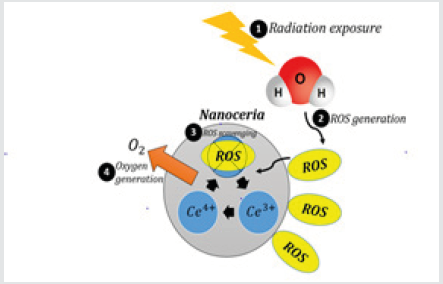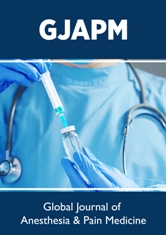
Lupine Publishers Group
Lupine Publishers
Menu
ISSN: 2644-1403
Opinion(ISSN: 2644-1403) 
The Role of Wound Healing and Protective Effect of Cerium Oxide Nanoparticles Volume 2 - Issue 1
Nouraddin Abdi Goushbolagh1* and Masoomeh Gholizadeh2
- 1Medical Physics Department, Shahid Sadoughi University of Medical Science, Iran
- 1Human Nutrition Department, Urmia University of Medical Sciences, Iran
Received:September 14, 2019; Published: September 19, 2019
Corresponding author: Nouraddin Abdi Goushbolagh, Medical Physics Department, shahid sadoughi University of Medical Science, Iran
DOI: 10.32474/GJAPM.2019.02.000130
Keywords: Cerium Oxide Nanoparticles; Free Radical; Reactive Oxygen Species
Opinion
While it is true that the humans are endangered by many dangers and may endure many pains, but the fact remains that some risks are inescapable. For one thing, the skin is the first defensive wall of the body against external hazards [1]. Ionizing radiation (skin burns and cancer), ultraviolet radiation (skin burns and cancer), physical blows, microorganisms and chemicals can cause serious injury and scarring to the skin [1-3]. For another, alcohol consumption give rise to gastric ulcers [4]. As far as we know, the presence of reactive oxygen species (ROS) at the injured site results in a delay at tissue repair [1]. Also, mega-voltage radiation in external radiation therapy and brachytherapy is a tool to killing of cancer cells by DNA doublestrand break and ROS generation. Actually, ROS instigate apoptosis and autophagy pathways synchronously [5]. Different materials are used to protect open and internal wounds against bacterial invasion and water loss, which divided into three groups: passive, interactive and bioactive products [1]. Cerium oxide nanoparticles (CONPs) or nanoceria as bioactive material have remarkable properties such as retinal neurodegeneration protection, and anti-inflammatory and antioxidant activities [6]. They can scavenge the free radicals and reproduce itself due to having individual electrical structure (Figure 1) [3]. CeO2 nanoparticles are able protect gastrointestinal ulcers against oxidative stress by dual oxidation states. As detail, nanoceria during ROS scavenging change oxidation state from Ce3+ to Ce4+ at the damage site. Regard to the (Figure 1), oxygen exchange between adsorbed species and the CONPs surface occur, which cause to the ce3+ recover again [4]. Self-regeneration is vital characteristic of CONPs, which makes them have a longer pharmacokinetic halflife than other protective drugs [3,7]. Thereby, this feature allows to use lower doses of nanoceria than other protective drugs to tissue repair and protect normal tissue against ionization radiation [8].
Figure 1: Schematic of self-regeneration of CONPs and ROS (generated by ionization radiation) scavenging by CeO2 nanoparticles.

As we know, size and shape of nanoparticles, stability and dispersivity, and cellular uptake are vital parameter to estimation of protective effects of CONPs [5]. Nanoparticles with various size have different rate of cell penetrate. Also, dispersivity determine value of CONPs cellular uptake. Because homogenous CONPs suspension have effective uptake in cells [5]. Hydroxylation is important enzymatic to wound healing, which exist in skin. Hence, it could be reasonably argued that the presence of it indicates better tissue repair. CONPs can reduce the number of inflammatory cells and increase hydroxyproline in the wounded area meaningfully [1]. Intrinsic defense enzymes such as superoxide dismutase (SOD) have a main role in free radical scavenging. Nanoceria can play the role of SOD in biological entities and protect gastrointestinal mucosa against alcohol [4]. Hence, the utilized of CONPs to diminish free radicals produced by any reason (ionization radiation, scarring, burn and alcohol) can be justified. However, the future studies should be determining the optimum concentration of CONPs for specific applications with considering of patient clinical information such as BMI as well as the structural properties of CONPs. Also, two important issues that challenge the researchers are targeted delivery of nanoceria at the wound area and accelerating the removal process of nanoparticle from the patient’s body after treatment.
References
- Davan R, Prasad R, Jakka VS, Aparna R, Phani A, et al. (2012) Cerium oxide nanoparticles promotes wound healing activity in in-vivo animal model. Journal of Bionanoscience 6(2): 78-83.
- Abdi Goushbolagh N, Keshavarz M, Zare MH, Bahreyni-Toosi MH, Kargar M, et al. (2019) Photosensitizer effects of MWCNTs-COOH particles on CT26 fibroblastic cells exposed to laser irradiation. Artificial cells, nanomedicine and biotechnology 47(1): 1326-1334.
- Abdi Goushbolagh N, Abedi Firouzjah R, Ebrahimnejad Gorji K, Khosravanipour M, Moradi S, et al. (2018) Estimation of radiation dose-reduction factor for cerium oxide nanoparticles in MRC-5 human lung fibroblastic cells and MCF-7 breast-cancer cells. Artificial cells, nanomedicine and biotechnology 46(3): 1215-1225.
- Prasad RGSV, Davan R, Jothi S, Phani A, Raju D (2013) Cerium Oxide Nanoparticles Protects Gastrointestinal Mucosa from Ethanol induced Gastric Ulcers in In-vivo Animal Model. Nano Biomedicine & Engineering 5(1).
- Goushbolagh NA, Farhood B, Astani A, Nikfarjam A, Kalantari M, et al. (2018) Quantitative cytotoxicity, cellular uptake and radioprotection effect of cerium oxide nanoparticles in MRC-5 normal cells and MCF-7 cancerous cells. Bio Nano Science 8(3): 769-77.
- Wang C, Blough E, Dai X, Olajide O, Driscoll H, et al. (2016) Protective effects of cerium oxide nanoparticles on MC3T3-E1 osteoblastic cells exposed to X-ray irradiation. Cellular Physiology and Biochemistry 38(4): 1510-1519.
- Ouyang Z, Mainali MK, Sinha N, Strack G, Altundal Y, et al. (2016) Potential of using cerium oxide nanoparticles for protecting healthy tissue during accelerated partial breast irradiation (APBI). Physica Medica 32(4): 631-635.
- Popov A, Zaichkina S, Popova N, Rozanova O, Romanchenko S, et al. (2016) Radioprotective effects of ultra-small citrate-stabilized cerium oxide nanoparticles in vitro and in vivo. RSC Advances 6(108): 106141- 106149.

Top Editors
-

Mark E Smith
Bio chemistry
University of Texas Medical Branch, USA -

Lawrence A Presley
Department of Criminal Justice
Liberty University, USA -

Thomas W Miller
Department of Psychiatry
University of Kentucky, USA -

Gjumrakch Aliev
Department of Medicine
Gally International Biomedical Research & Consulting LLC, USA -

Christopher Bryant
Department of Urbanisation and Agricultural
Montreal university, USA -

Robert William Frare
Oral & Maxillofacial Pathology
New York University, USA -

Rudolph Modesto Navari
Gastroenterology and Hepatology
University of Alabama, UK -

Andrew Hague
Department of Medicine
Universities of Bradford, UK -

George Gregory Buttigieg
Maltese College of Obstetrics and Gynaecology, Europe -

Chen-Hsiung Yeh
Oncology
Circulogene Theranostics, England -
.png)
Emilio Bucio-Carrillo
Radiation Chemistry
National University of Mexico, USA -
.jpg)
Casey J Grenier
Analytical Chemistry
Wentworth Institute of Technology, USA -
Hany Atalah
Minimally Invasive Surgery
Mercer University school of Medicine, USA -

Abu-Hussein Muhamad
Pediatric Dentistry
University of Athens , Greece

The annual scholar awards from Lupine Publishers honor a selected number Read More...




